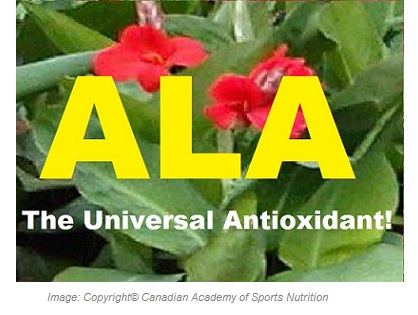Also known as thioctic acid, ALA is a sulfur-containing vitamin-like  substance with a potent antioxidant activity. It is soluble in both water and fat and this is why it is sometimes referred to as the “universal antioxidant”. ALA can easily cross cell membranes. The main free radicals neutralized by ALA are singlet oxygen and hydroxyl radicals.
substance with a potent antioxidant activity. It is soluble in both water and fat and this is why it is sometimes referred to as the “universal antioxidant”. ALA can easily cross cell membranes. The main free radicals neutralized by ALA are singlet oxygen and hydroxyl radicals.
The two main functions of ALA are (1) helping to recycle vitamin C, vitamin E, glutathione, and Co –Enzyme Q10, and (2) improving sensitivity of the cells to insulin.
Natural Sources of ALA:
ALA is produced in a small amount in the body. It is also found in the organ meats such as liver, kidney, and heart, yeast, and broccoli.
Benefits of ALA:
ALA may be beneficial in the following conditions:
- Diabetes type II.
- Diabetic neuropathy.
- Catarcts.
- Glaucoma.
- Hepatitis.
- HIV/AIDS. ALA has the ability to inhibit the replication of HIV by reducing the activity of reverse transcriptase.
- Heavy metal toxicity. ALA is a potent chelating agent that chelates mercury.
- Adjuvant therapy in MS (multiple sclerosis).
- Altering body composition (it shows better results when combined with exercise).
- Male infertility.
- Cardiovascular disease.
- Metabolic syndrome.
- Liver detoxification.
For athletic benefits of ALA, see “ALA (Alpha-Lipoic Acid)” under the section of “Sports – Perfromance Enhancers“.
Dosage, Side Effects, and Interactions:
The dosage of ALA varies based on the conditions for which it is used. It is usually between 200 to 800 mg a day. Possible side effects are numbness and tingling, skin rash, and hypoglycemia.
Long-term consumption of ALA might interfere with the function of biotin.
There are few studies indicating that ALA may exhibit pro-oxidant activity as well.

